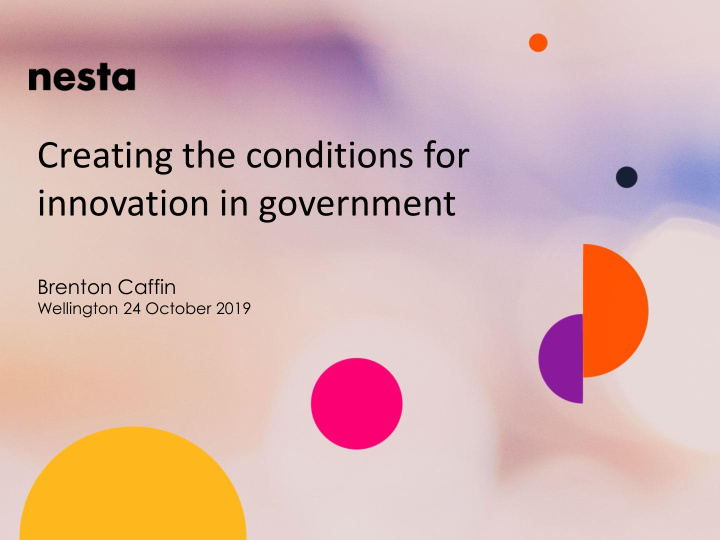



Creating the conditions for innovation in government Brenton Caffin Wellington 24 October 2019
Innovation in a public policy context Creating the conditions for innovation The role of leadership 50 shades of failure Discussion
Source: AFP
What does innovation in government look like around the world…
Source: Museum of the Future, Dubai
Policy Lab Co-creating policy with the people affected
So how do we make this happen?
Landscape of innovation approaches
Six principles to explore the unobvious
Creating space for innovation craft
Rehearsing new practices
Building new competencies
The role of leadership
Public policy A design problem? “How can you make sensible policy or strategy in a nondeterministic, evolutionary, highly complex world, that is, a world where the most desirable outcomes are unknown but there may be many possible acceptable outcomes, where change is characterized by both path dependence and unpredictability, and where there are many diverse components, interactions, and feedback among components and multiple dimensions to each problem? This is the design problem with respect to public policy.” Carlsson (2004:36)
Alternative governance models LEGACY: Traditional CURRENT: New FUTURE: Networked public administration Public Management governance Context Stable Competitive Continuously changing Population Homogeneous Atomized Diverse Needs/problems Straightforward, defined Wants, expressed Complex, volatile by professionals through the market and prone to risk Strategy State and producer Market and customer Shaped by civil centred centred society Governance Hierarchies Markets Purchasers Networks and through actors Public servants and providers Clients partnerships and contractors Civic leadership Key concepts Public goods Public choice Public value Source: Adapted after Jean Hartley (2005)
Challenge #1: Empathic data “To employees long accustomed to being told to be rational and objective, these methods can seem rather subjective and personal. Businesses want to understand their customers, of course, but design thinking approaches to connecting with customers can feel too close, uncomfortably emotive, sometimes overwhelmingly affecting.” Austin, R. & Bason, C. (2018) The Right Way to Lead Design Thinking. HBR
Challenge #2: Iteration “Design methods ask employees not to race to the finish line, not to converge on an answer as quickly as possible, and instead to widen the set of options — to go sideways for a while rather than forward. This can be difficult for people schooled in the need for efficiency, the importance of cost savings, the value of being lean, and so on. It can feel like “spinning wheels” because it kind of is.” Austin, R. & Bason, C. (2018) The Right Way to Lead Design Thinking. HBR
Challenge #3: Learning to fail forward “If that were not enough, design approaches also call on employees to often experience something that they have historically tried to avoid: failure. The aspects of these methods that involve iterative prototyping and testing work best when they produce lots of negative results, outcomes that show you what does not work. But piling up seemingly unsuccessful outcomes does not feel good to most people.” Austin, R. & Bason, C. (2018) The Right Way to Lead Design Thinking. HBR
The Practice of Adaptive Leadership: Tools and Tactics for Changing your Organisation and the World. Ronald Heifetz, Alexander Grashow, Martin Linsky. Harvard Business Press, 2009
The Practice of Adaptive Leadership: Tools and Tactics for Changing your Organisation and the World. Ronald Heifetz, Alexander Grashow, Martin Linsky. Harvard Business Press, 2009
50 shades of failure
When have you experienced failure?
What caused the failure ?
Would you consider it a GOOD or BAD failure?
Causes of failure Deviance Inattention Process complexity Process inadequacy Uncertainty Lack of Lack of ability evidence Task challenge
Spectrum of failure Source: Amy Edmondson “Spectrum of Reasons for Failure” in “Strategies for Learning from Failure” (Harvard Business Review, A pril 2011
Where is your failure on this spectrum? Source: Amy Edmondson “Spectrum of Reasons for Failure” in “Strategies for Learning from Failure” (Harvard Business Review, A pril 2011
A new rhetoric (or perhaps an old one) Source: The Observer (1832)
“The country needs and unless I mistake its temper the country demands bold persistent experimentation. It is common sense to take a method and try it. If it fails admit it frankly and try another. But above all try something .” ― Franklin D. Roosevelt
Source: AFP
nesta.org.uk @nesta_uk Discussion
Recommend
More recommend